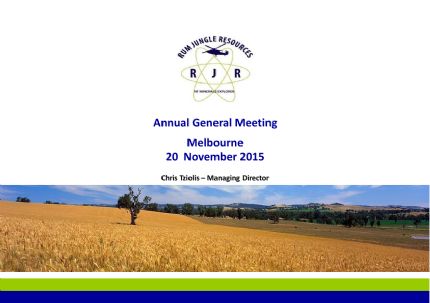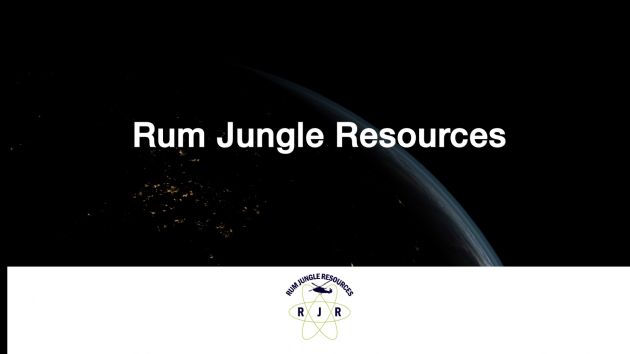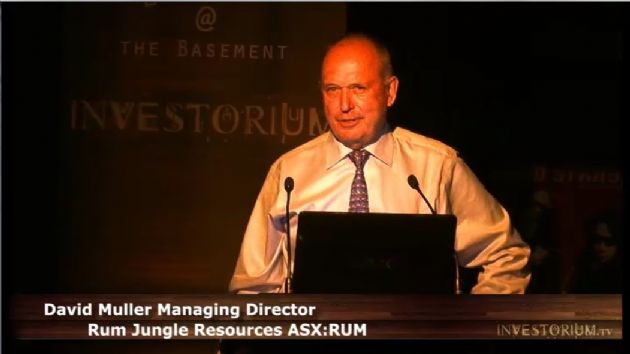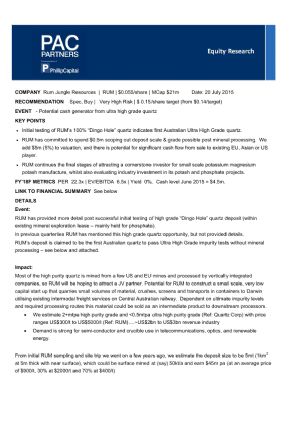 Dingo Hole Silica - Initial Processing Results
Dingo Hole Silica - Initial Processing Results
Perth, Oct 23, 2015 AEST (ABN Newswire) - Rum Jungle Resources Ltd ( ASX:RUM) are pleased to provide an update on the Dingo Hole Silica - Initial Processing Results.
ASX:RUM) are pleased to provide an update on the Dingo Hole Silica - Initial Processing Results.
Background
Rum Jungle Resources Ltd (RUM) announced initial surface sampling silica exploration results to the ASX on 20 July 2015. Subsequently, Rum Jungle Resources engaged Dorfner Anzaplan of Germany to conduct initial processing test work on surface samples collected from the Dingo Hole Silica project. Approximately 100 kg of sizeable quartz rock lumps, randomly collected from the surface at Dingo Hole, were sent to Dorfner Anzaplan in July 2015.
Mineralogical and metallurgical tests were conducted to identify the presence and nature of impurities. A portion of the quartz rock fragments was autogenously ground and sized so that further physical (flotation, magnetic separation), chemical (acid leaching, hot chlorination) and thermal (calcination) processing tests could be conducted in order to remove impurities. This processing route represents the traditional processing path for the production of High Purity Quartz (HPQ) globally. This initial phase of metallurgical processing test work is now complete.
Initial Metallurgical Test Work Results
The test-work sample utilised by Dorfner Anzaplan had a relatively high level of initial measured impurities (2,600 ppm) that included approximately 2,055 ppm of calcium, which is significantly higher in impurities than the majority of samples previously assayed as part of the program of surface sampling work conducted at Dingo Hole. Analysis of Dingo Hole rock samples to date does indicate a reasonable amount of variability in impurities.
On a positive note, the primary process test work reduced the measured impurities to approximately 119 ppm, which is in the range of what could be considered as low to medium grade HPQ. However, industrial utilisation and the association of IOTA high purity quartz standard with such products is contingent on the makeup of the impurities that remain after processing. In most cases, aluminium, lithium and titanium can be problematic but in the case of Dingo Hole, these elements seem to be manageable. However, in the case of the Dorfner Anzaplan sample, elevated levels of calcium, magnesium, iron and boron that remained in place after processing tests, did not meet the IOTA standard for varying uses of HPQ. These particular impurities have a detrimental effect on the creation of high end silica products and even lower value optical glass and semi conductor fillers. This is primarily due to excessive bubbling that occurs when the silica is melted to create glass. Reduction of impurities that cause this bubbling will be a necessity.
Therefore, at this point, it cannot be categorically stated that a marketable HPQ product can, or cannot, be produced from the Dingo Hole Silica project. Accordingly, this is very early stage and more work is required but there is no guarantee that an IOTA standard, marketable HPQ can ultimately be produced based on processing test-work to date.
Moving Forward
RUM will now consult with local and overseas silica experts and will conduct further discussions with Dorfner Anzaplan regarding the way forward. Topics of discussion will include:
- better understanding of sample selection and preparation that may impact test-work results
- potential of alternate processing methods to remove problematic impurities including optical sorting, different grind sizes, different flotation reagents, additional flotation stages, acid gestation times and pyro-metallurgical processes
- the potential of starting with lower impurity feedstock in the next phase of processing test work which may enable the right impurity levels to be attained at the end
- understanding of the future use cut-off grades for certain elements in feedstock to enable IOTA standard HPQ production
- more systematic sampling and/or drilling of the mineralised area to more fully understand the chemical distribution of the SiO2 and the impurities
- engaging the HPQ industry to understand potential uses for this quality of product which may differ from normal standards
Furthermore, RUM, through a study of publically available information, satellite imagery and geological maps, has identified a number of other areas with the Northern Territory that may host pedogenic chalcedonic silica rock (white quartz), similar to Dingo Hole. Exploration License Applications have been submitted and some initial analysis of rock samples will be conducted to ascertain the quality of these new potential deposits and to compare with the Dingo Hole white quartz.
Conclusion
Whilst the initial test-work results have not met the rigid IOTA standards for HPQ, this project is at an early stage of its evolution and more systematic sampling, analytical and test work needs to be done. Moreover, the HPQ industry is small and has limited transparency, so further understanding of the markets, its participants, quality requirements and potential end uses will also be critical.
About Verdant Minerals Ltd
 Verdant Minerals Ltd's (ASX:VRM) strategic intent is to create shareholder value through the discovery, development and operation of fertiliser and industrial mineral projects, located in close proximity to existing transport infrastructure, with a primary focus on the Northern Territory of Australia.
Verdant Minerals Ltd's (ASX:VRM) strategic intent is to create shareholder value through the discovery, development and operation of fertiliser and industrial mineral projects, located in close proximity to existing transport infrastructure, with a primary focus on the Northern Territory of Australia.
![abnnewswire.com]()
Related Companies
Social Media
Share this Article

 ASX:RUM) are pleased to provide an update on the Dingo Hole Silica - Initial Processing Results.
ASX:RUM) are pleased to provide an update on the Dingo Hole Silica - Initial Processing Results. Verdant Minerals Ltd's (ASX:VRM) strategic intent is to create shareholder value through the discovery, development and operation of fertiliser and industrial mineral projects, located in close proximity to existing transport infrastructure, with a primary focus on the Northern Territory of Australia.
Verdant Minerals Ltd's (ASX:VRM) strategic intent is to create shareholder value through the discovery, development and operation of fertiliser and industrial mineral projects, located in close proximity to existing transport infrastructure, with a primary focus on the Northern Territory of Australia.









